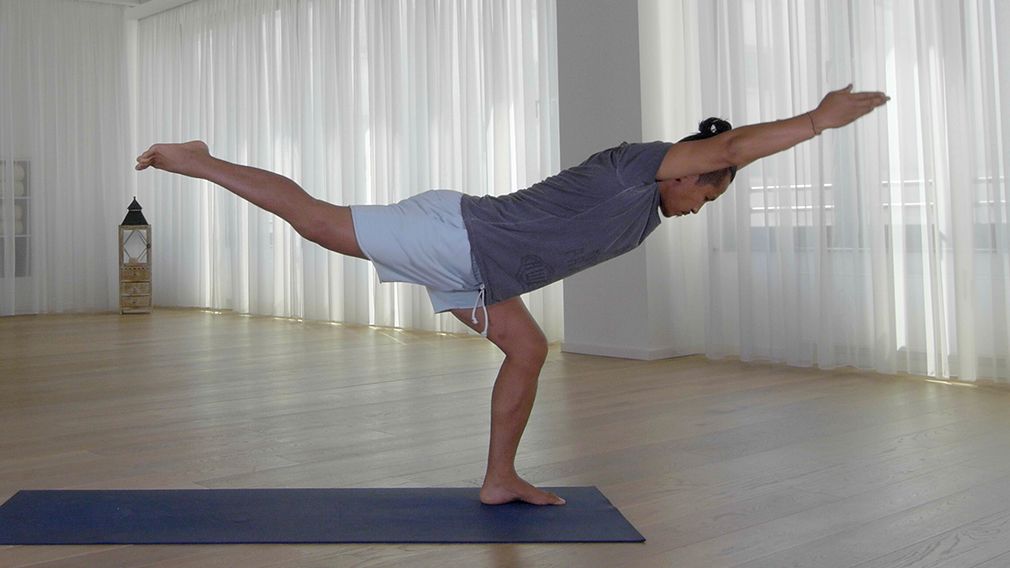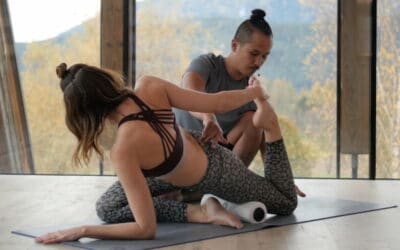Warrior 3 – or Virabhadrasana 3 as it is called in Sanskrit – is a standing balance yoga pose and the third variation of the warrior series.
These asanas are very commonly integrated into a yoga sequence and are also often underestimated in regard to their benefits to the body and mind. While Warrior 1 and Warrior 2 tend to be yoga poses that beginners can be introduced to, Warrior 3 is regarded to be for slightly more experienced yogis (intermediate level).
However, whether beginner, intermediate or advanced, this asana will stop yogis from overthinking inner struggles and get them back into their moving body. Why? It challenges yogis to consciously activate the strength of the legs’, arms’ and torso’s muscles, to focus, and to find physical and mental balance and steadiness.
Find out all you need to know about warrior 3 yoga pose:
- 1. How to Do Virabhadrasana 3 (Warrior 3)?
- 2. What Is Your Body Doing in Warrior 3 Yoga Pose?
- 3. Where Did Virabhadrasana 3 (Warrior 3) get its name from?
- 4. How Do You Build Warrior 3 Into Your Yoga Sequence?
- 5. What Are Possible Warrior 3 Variations?
- 6. When To Avoid Virabhadrasana 3?
- 7. What Are the Benefits of Warrior 3 Pose?
1. How to Do Virabhadrasana 3 (Warrior 3)?
Warrior 3 is a great pose to feel the Self-Love Magic. Photo: TINT Instructor Barbra Noh.
1. Start in Warrior 1.
2. Place both hands onto the hip bones. The front leg is going to be the standing leg.
3. Lift your back heel to straighten the foot and further square the hips. Tuck your navel in and up.
4. Keep the standing leg bent while you start shifting your bodyweight slowly onto your front leg. Start activating your back muscles.
5. Place or pull the back foot a few centimeters forward. Your gaze (Drishti) is focussed on a non-moving point on the ground, about half a meter in front of your standing foot.
6. Once you feel safe and well-balanced, inhale and lift the back leg by engaging your back thigh muscles and glutes. Your weight is evenly distributed on the four corners of your standing leg’s foot.
7. Keep the pelvis straight like in Warrior 1, meaning parallel to the mat, and tilt your upper body forward, so that your chest is also parallel to the mat. If it is available to you, your back leg and your upper body are in line with each other.
8. Flex the lifted back foot, toes point down, and engage the foot by actively pushing the heel away from you.
9. Your standing leg remains micro-bent and engaged – you are allowed to be slightly shaky. Focus on the engagement of all necessary muscles and you will find more balance. Remember your Drishti.
10. The crown of your head pulls away from your shoulders, elongating the neck and spine.
11. If it is available to you and you feel in balance, then reach your arms towards the front of your mat. Keep them strong, your shoulders might lift slightly to move your ribcage forward and up to give your lungs more room to breathe. Your palms face each other and your fingers are engaged.
12. Remember to breathe consciously through your nose (ujjayi breath). Back foot and hands reach away from each other and stretch.
13. To release the pose, exhale, bend the standing leg more and place your lifted foot back onto the ground.
14. Inhale and engage your core to rise back up into Warrior 1.
If you feel ready to practice Virabhadrasana 3 and the other warrior asanas, then flow for 30 minutes with TINT Instructor Barbra Noh through some gentle Self-Love Magic, focusing on balance.
Alternatively, TINT Instructor Sianna Sherman, founder of Rasa Yoga, takes you through a 35-minutes challenging sequence, the Way of the Warrior, helping you to cultivate clear inner sight. Sianna also includes many binds, strong standing balances, and reminds you throughout the practice of your own eagle wings.
Explore various versions of Warrior 3 and other warrior poses in Sianna Sherman‘s 35-minute class Way of the Warrior on TINT.
2. What Is Your Body Doing in Warrior 3 Yoga Pose?
It is very important to know about the alignment of the body to always be safe and feel comfortable while practicing yoga. For everyone who enjoys learning more about alignment, we put together this easy-read ebook, free to download.
2.1. Upper Body
Let’s look at the upper body first:
In Virabhadrasana 3, the spine is neutral due to the spinal flexors and extensors supporting to calibrate concentric and eccentric contractions. So the back muscles are strong.
Moreover, the psoas minor and the abdominal muscles contract to prevent the lumbar spine from hyperextending. To help with the abs, tuck the navel in and up.
The sternum is minimally lifted proudly, and the chest is open. The neck muscles contract as well to support the cervical spine carrying the head’s weight.
In addition, the shoulders are abducted and, if the arms reach forward above the head, the arms are pronated and the triceps engaged. The muscles in hands and fingers are actively extended.
2.2. Lower Body
Now, let’s move on to the lower body:
In the standing leg, the quad muscles are engaged, the articularis genu and vastii flex to lift the patella of the knee. The glute muscles contract to support the abduction and flexion of the hip. The pelvis bones are parallel to the ground and slightly tilted up. All muscles of the foot support the integrity of the foot.
In the back leg, the femur is internally rotated so that the knee and foot both point to the ground. Also here, the hamstrings, quads, and muscles around the knee contract to lift the leg and the patella. The foot muscles and calf are engaged to flex the foot. Imagine your heel pushes away from your calf.

The yoga pose Warrior 3 engages many parts of the body. Photo: TINT Instructor Young Ho Kim.
3. WhEre Did Virabhadrasana 3 (warrior 3) get its Name from?
Imagine you are combating and defeating someone with your sword. Do you find this a not very yogi-like image for an asana due to its principle of non-violence (ahimsa)? Then find out about the mythological background of the warrior poses now and you will understand this image.
Virabhadrasana originates from the name Virabhadra who, as it is said, was a warrior created by Shiva’s anger and despair. But let’s go back slightly in the story: Daksha, father of Sati who is the wife of Shiva, does not approve of Shiva as a son-in-law. So he excludes Shiva from family events, even shuns him to demonstrate his disdain. This upsets Sati to a degree that the fire burning inside of her grows until she bursts into flames. Now, Shiva, in his grief and anger, cuts off one of his dreadlocks, throws it on the floor – and then Virabhadra appears. Shiva tells him to storm the Daksha’s palace, Sati’s father and king, as revenge.
Here come the warrior asanas: So Virabhadra bows one knee and raises the arms up in service of Shiva who orders him to lead the army (Warrior 1). Then Virabhadra wields his sword and is ready for battle (Warrior 2) and to take the army to the palace. When they arrive, he finds Daksha and swings his sword to behead him (Warrior 3).
When Shiva sees and realizes the damage his ordered army has done, he regrets the innocent lives lost. As a sign of letting go of his anger and replacing it with compassion, he replaces Daksha’s head with the head of a goat. Thereby, he resurrects Daksha who then bows to Shiva to show his respect towards him and Shiva’s deep love and loyalty to Sati (Humble Warrior).
As is often the case with stories, there is a meaning behind it or a lesson to be learned: Virabhadrasana does not actually refer to fighting. Rather, it metaphorically reminds yogis to overcome the ego, the mind, and self-ignorance. It states: Be brave, stand firm, and take action in tough times, connecting to your heart’s whisper and inner strength. That way, Warrior 3 helps you to push through inner conflicts.
Sianna Sherman’s series Rasa Warrior Practice takes you on a journey through the mythology behind various warriors and on to exploring how their strengths can be found within you.
4. How Do You Build Warrior 3 Into Your Yoga Sequence?
You might have been inspired already by the transitions that Barbra Noh and Sianna Sherman use in their practices mentioned above. When integrating it into the sequence, it is important to remember that Warrior 3 is an intermediate standing balance. We collected a few examples of standing asanas that almost naturally let yogis ease into the strength of Virabhadrasana 3:
- Mountain pose (Tadasana)
- Warrior 1
- Warrior 2
- High Lunge.
When teaching experienced yogis, you might enjoy transitioning from the following standing balances into Virabhadrasana 3. They offer to keep the leg off the ground at all times while the standing leg might start burning:
- Half-Moon pose (Ardha Chandrasana)
- Eagle pose (Garudasana)
- Hand To Big Toe pose (Utthita Hasta Padangusthasana).
Some of these asanas also make good follow-up poses when coming out of Warrior 3, like stepping back into High Lunge or coming back to Tadasana. Additionally, afterwards you might enjoy transitioning into:
- Chair pose (Utkatasana)
- Tree pose (Vrksasana)
- Standing Half-bound Lotus (Ardha Baddha Padmottanasana)
- Figure 4 (Eka Pada Utkatasana).
Always keep in mind the level your students are at and give options if it is a mixed class and you still like to offer challenges to body and mind.
5. What Are Possible Warrior 3 Variations?
There are several options that help reaching Virabhadrasana 3 step by step.
- Of course, you may stop lifting your leg at the degree that feels comfortable for you. You may even start by keeping the tips of your toes on the ground and leaning forward only slightly, remaining the torso and back leg in line. From practice to practice, you will be able to lean forward more and to lift the back leg further.
- You may use a chair to gently hold onto to help you with the balance. Make sure you do not rest them on the chair but keep the arms engaged.
- You may place your back foot against a wall. This will help you balance while you actively push your foot away from you into the wall, engaging your core and leg muscles.
- If you notice that straightening your arms above your head causes you to lose balance, then you may either bring your hands to heart-center in Anjali Mudra, reach your arms sideways, or reach your arms backwards like the wings of an airplane, palms facing towards the ground. The latter option will help you open your chest and ease your shoulders and neck if you struggle with tightness or soreness in that area.
- If it feels good with your neck and shoulders while your arms reach forward, you may also interlock your hands and point your index fingers (Kali Mudra).
For an increasing feeling of security and stability in your standing balances, we put together the 10 most helpful recommendations on how to improve similar asanas.
6. When To Avoid Virabhadrasana 3?
There are a few contraindications that, if they are known to the yogi, require to refrain from practicing Warrior 3 or to stay in the option of leaving the toes of the back foot on the ground and only slightly leaning forward:
- Chronic back, shoulder, hip or leg injury: If your body screams pain, don’t do it. This accounts for any asana.
- Pregnancy: choose an easy option here, so the abdominals do not need to be engaged
- High blood pressure: For some people, the rush of blood to the head may cause dizziness or similar uncomfortable bodily sensations.
7. What Are the Benefits of Warrior 3 Pose?
Virabhadrasana 3 truly engages the whole body, resulting in several benefits on both a physical and an energetic level.
Regarding your physique, Warrior 3 benefits glutes and the hip stabilizers as well as the muscles in legs and feet, strengthening their deep tissue. Moreover, it empowers the core and back muscles that need to cooperate to support each other and become the powerhouse of your body. These muscles also help neutralize, align and elongate your spine. Overall, your stability as well as your ability to balance increase.
Another physical benefit of Virabhadrasana 3 is the active opening and stretching of the chest and shoulder muscles that, especially in today’s smartphone age of slumped upper backs, realign and thereby improve your overall healthy posture. This also widens the rib cage slightly, giving the lungs more room and thereby enhancing your lungs’ capacity. Since Warrior 3 involves several muscles and requires a great amount of attention to alignment, the asana supports your full-body coordination.
On an energetic level, Warrior 3 also benefits your inner emotional and energetic balance. It will calm you and help you clear your mind. The intensity of the pose requires and thereby fosters your ability to focus and concentrate. When holding the pose and breathing, your awareness of your own inner strength, your ability to move and balance, and your inner energy increases. Furthermore, due to the stability and rooting down of the standing leg, Virabhadrasana 3 has grounding effects.
Generally, standing asanas and standing balances help the body to ground and connect to the earth. For example, if you have been on a plane for several hours, your body will welcome some asanas of that kind to balance your Vata element.
Now, as you have learned about the amazing benefits of Warrior 3, why don’t you get moving and start with some Warrior Poses for Beginners with TINT Instructor Hie Kim. Or head over to the Hands-Free Flow including Warrior 3 pose with TINT Instructor Ami Norton to build some strong roots, find inner peace and push through inner conflict.









